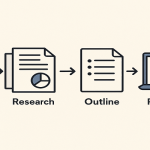Introduction
Search engine optimization (SEO) is often misunderstood as a technical skill, but at its core, it’s about creating content that both search engines and human readers love. Whether you’re a blogger, content marketer, or business owner, understanding SEO will help your articles reach the right audience and rank higher in search engine results.
This guide will simplify the essential SEO strategies you need to maximize your article’s visibility. We’ll break it down into five key areas: understanding search intent, on-page SEO, off-page SEO, content freshness, and essential SEO tools. By the end, you’ll have actionable steps to improve your rankings and drive more traffic to your content.
1. Understanding Search Intent and Keyword Research
Before you even start writing, you need to understand what your audience is searching for. This is where keyword research comes in.
What Is Search Intent?
Search intent refers to the reason behind a search query. Google aims to deliver the most relevant results based on what a user is looking for. There are four main types of search intent:
- Informational – The user wants to learn something (e.g., “How to optimize an article for SEO”).
- Navigational – The user is looking for a specific website or page (e.g., “Moz keyword research tool”).
- Transactional – The user is ready to buy or take action (e.g., “Best SEO tools for bloggers”).
- Commercial Investigation – The user is comparing options before making a decision (e.g., “Ahrefs vs. SEMrush: Which is better?”).
Your goal is to match your content with the user’s intent. For example, if someone searches for “How to do keyword research,” they expect a step-by-step guide, not a sales pitch.
How to Find the Right Keywords
- Brainstorm Topics – Think about what your audience is interested in.
- Use Keyword Tools – Tools like Google Keyword Planner, Ahrefs, and Ubersuggest can help you find keyword ideas.
- Analyze Search Volume & Competition – Look for keywords with a good balance of search volume and competition.
- Check Search Engine Results – Type your keywords into Google and analyze the top results. What type of content is ranking?
- Use Long-Tail Keywords – Phrases with three or more words (e.g., “best SEO practices for beginners”) tend to have lower competition and higher conversion rates.
Pro Tip:
Focus on LSI (Latent Semantic Indexing) keywords – these are related terms that Google associates with your main keyword. For example, if your keyword is “SEO tools,” related terms might include “keyword research tools,” “SEO analytics,” and “Google ranking factors.”
2. On-Page SEO: Titles, Meta Descriptions, and Internal Linking
Once you’ve chosen your keywords, it’s time to optimize your content. On-page SEO refers to elements within your article that affect its ranking.
Optimizing Your Title and Headings
Your title is the first thing users and search engines see. Here’s how to make it SEO-friendly:
- Include your primary keyword – Place it naturally within the title.
- Make it compelling – Use numbers, power words, or questions to attract clicks (e.g., “10 Proven SEO Techniques to Boost Your Rankings”).
- Keep it under 60 characters – Google truncates longer titles.
Use headings (H1, H2, H3) to structure your content. This makes it easier for both users and search engines to read and understand.
Writing Effective Meta Descriptions
The meta description is the short snippet below your title on search engine results pages. While it doesn’t directly impact rankings, a well-crafted meta description increases your click-through rate (CTR).
- Keep it under 160 characters
- Include your main keyword
- Make it enticing – Give users a reason to click
Internal Linking: Boosting SEO and User Engagement
Internal links guide users to other relevant content on your site. This improves user experience and helps search engines understand your website structure.
Best practices:
- Link to related articles naturally within your content
- Use descriptive anchor text (instead of generic “click here”)
- Ensure older articles link to newer ones when relevant
3. Off-Page SEO: Backlinks and Social Signals
On-page SEO isn’t enough. Google also considers external factors like backlinks and social signals to determine your content’s authority.
What Are Backlinks?
Backlinks are links from other websites to your content. High-quality backlinks signal to Google that your article is trustworthy and valuable.
How to Earn Quality Backlinks
- Guest Blogging – Write articles for other reputable websites in your niche.
- Create Link-Worthy Content – Publish in-depth guides, original research, or unique insights.
- Broken Link Building – Find broken links on other sites and suggest your article as a replacement.
- Get Featured on Industry Websites – Participate in expert roundups or contribute quotes to high-authority sites.
The Role of Social Signals in SEO
Although social shares aren’t a direct ranking factor, they increase visibility, traffic, and potential backlinks. Promote your content on:
Encourage sharing by adding social share buttons and crafting engaging headlines.
4. The Role of Content Freshness in Rankings
Google prioritizes fresh content, especially for trending topics. But that doesn’t mean you need to publish new content constantly updating old content is just as effective.
How to Keep Your Content Fresh
- Update Statistics and Facts – Replace outdated data with current sources.
- Improve Readability – Break up long paragraphs, add bullet points, and update images.
- Add New Insights – Expand your content with new strategies or case studies.
- Republish with a New Date – If you make significant updates, change the publication date to signal freshness to search engines.
Regularly revisiting and improving your content helps maintain rankings and keeps your audience engaged.
5. SEO Tools and Resources Every Writer Should Use
You don’t have to do SEO alone. These tools make optimization easier:
Keyword Research Tools
- Google Keyword Planner
- Ahrefs
- SEMrush
- Ubersuggest
On-Page SEO Checkers
- Yoast SEO (WordPress plugin)
- Rank Math
- Surfer SEO
Backlink Analysis Tools
- Ahrefs
- Moz Link Explorer
- Majestic
Content Optimization & Tracking
- Google Search Console
- Google Analytics
- Clearscope
Investing in the right tools saves time and improves your SEO efforts.
SEO Is a Long-Term Game
SEO isn’t about quick wins it’s about consistently optimizing and improving your content. By focusing on search intent, on-page SEO, off-page SEO, content freshness, and the right tools, you’ll increase your article’s visibility and drive more organic traffic.
Start by applying these strategies to your next article and monitor your rankings over time. SEO success doesn’t happen overnight, but with patience and persistence, you’ll see significant improvements.
Now it’s your turn! What SEO strategy has worked best for you? Let’s discuss in the comments!



